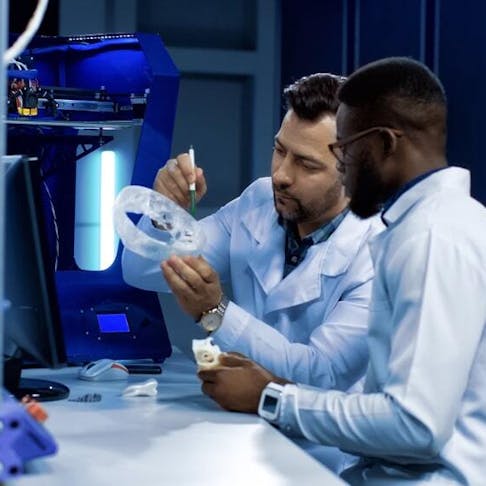Prosthetics 3D printing is the use of 3D printers to design and create artificial, wearable body parts such as legs, hands, and arms. It is a relatively new method compared to the traditional method of production. The materials used in creating 3D printed prosthetics are accessible and lightweight, making the process suitable for producing prosthetics and providing a favorable alternative for patients worldwide.
This article will further discuss 3D printing in prosthetics, how it is used, its history, cost, and benefits.
What Is 3D Printing in Prosthetics?
Prosthetics 3D printing is the use of additive manufacturing technologies rather than traditional subtractive manufacturing methods to create artificial body parts. These body parts may have been lost through traumatic events or congenital disorders (present at birth). In some cases, amputation surgery may be necessary when a victim's limb or limbs are affected severely by a disease that leads to its atrophy and decomposition (gangrene). In any case, 3D-printed prosthetics serve as a replacement for the missing limbs.
For more information, see our guide on 3D printing.
3D printing has proven useful in creating prosthetics for a number of reasons. Using 3D printing to fabricate prosthetics leads to a considerable reduction in the manufacturing time, cost, and weight of prosthetics. Prosthetics produced by traditional methods require stringent procedures and are expensive. A prosthetic arm is usually more than $2,000, and the amputee may need to wait for long periods (between 3–6 weeks) for production and delivery to take place. Prosthetics 3D printing, on the other hand, is affordable, has a short lead time, and the required materials are readily available. A 3D-printed arm can cost $395 and be produced in one day.
The History of 3D Printed Prosthetics
Scientists and medics made efforts to create 3D-printed prosthetics from 1990 to 1999. There was a breakthrough as their research saw the creation of the first 3D dental implants and organs. However, 3D-printed prosthetic arms, fingers, hands, or legs were still a subject of exploration. Finally, in 2011, a prototype of a 3D-printed prosthetic hand was created.
American artist, Ivan Owen, created the first 3D-printed prosthetic in 2011. A 3D printed prosthetic was not his first creation though—it was a mechanical hand. He created this for a steampunk convention and posted a video online of the crafting process. After another collaboration with a carpenter amputee, the project caught the attention of a mother. Her son needed an artificial hand, and prosthetics then were expensive. Owen got to know about her and requested that a 3D printer manufacturing company donate two 3D printers. His request was granted and he created the first 3D-printed prosthetic hand. The issue of the son outgrowing the prosthetic wasn't much of a problem because the printed hand allows for scalability.
The Most Common 3D Printed Prosthetics
The most common 3D printed prosthetics are:
- 3D Printed Prosthetic Hand: Prosthetic hands are made for people who have suffered the loss of a limb from the wrist. E-nable prosthetics, an association that oversees a network of makers, enthusiasts, or humanitarians, create different 3D models of prosthetics hands. Some of these models are printed and donated to hundreds of people across the world.
- 3D Printed Prosthetic Arm: Prosthetic arms can be a combination of a hand and forearm, or a hand, arm, and forearm. Hero prosthetics are acknowledged as the first clinically-approved 3D printed prosthetic arm. Among its functionalities are high five, grab, thumbs up, and pitch. It is aesthetically pleasing and loved especially by children because of the variety of super action figures it represents. The myoelectric functionality makes it possible for the user to have a certain level of control over their 3D printed arm prosthetic.
- 3D Printed Prosthetic Foot: Prosthetic feet allow users to walk. These are usually made with either elastic heel configurations or solid ankle cushioned heels (SACH). Upya by Exoneo is an affordable, dynamic, and fully biomechanical prosthetic foot that copies the actual anatomy of the toes, ankle, and heel. This allows users to experience the same feeling as a natural foot.
For more information, check out our online 3D printing service for your needs.
Disclaimer
The content appearing on this webpage is for informational purposes only. Xometry makes no representation or warranty of any kind, be it expressed or implied, as to the accuracy, completeness, or validity of the information. Any performance parameters, geometric tolerances, specific design features, quality and types of materials, or processes should not be inferred to represent what will be delivered by third-party suppliers or manufacturers through Xometry’s network. Buyers seeking quotes for parts are responsible for defining the specific requirements for those parts. Please refer to our terms and conditions for more information.

